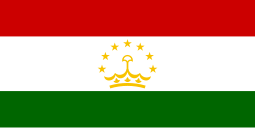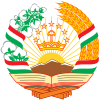Flag of Tajikistan
 | |
| Tajik: Парчами Тоҷикистон/Parcami Toçikiston Persian: پرچم تاجیکستان | |
| Use | National flag |
|---|---|
| Proportion | 1:2 |
| Adopted | 24 November 1992[1] |
| Design | A horizontal tricolor of red, white and green; charged with a crown surmounted by an arc of seven stars at the center |
The national flag of Tajikistan (Tajik: Парчами Тоҷикистон / Parcami Toçikiston, Persian: پرچم تاجیکستان) was adopted in November 1992, replacing the flag of the Tajik Soviet Socialist Republic of 1953. The flag of Tajikistan is a horizontal tricolor of red, white and green with a width ratio of 2:3:2, charged with a crown surmounted by an arc of seven stars at the centre.[2]
The tricolor preserves the choice of colors in the former Tajik Soviet flag due to their Iranian influence as an ethno-linguistically Iranian people. These colors have been used to represent Iran since the 19th century and were first introduced as an alternative banner during the 18th century. This flag also retains the 1:2 proportion of the Soviet predecessor.
National flag
The flag of Tajikistan is a tricolour of red, white, and green. The red represents the unity of the nation as well as victory and sunrise. The white represents purity, morality, the snow and ice of the mountains, and cotton.[2][3][4][5] The green represents the bountiful generosity of nature, fertile valleys, and the religion of Islam, and the celebration of Novruz.[5]
While the red and green stripes on the top and bottom are equal in size, the center stripe is one-and-a-half times that of the others.
The crown and stars are set in a rectangle taking up 80% of the white stripe's height. The crown represents the Tajik people, as the name Tajik is connected with Persian tâj "crown" in popular etymology.[6] The flag of Tajikistan features seven stars due to the significance of the number seven in Tajik traditional legends, representing perfection and happiness while alluding to a traditional belief that the heavens feature seven mountains and seven orchard gardens with a star shining above each mountain.[5]
The flag day is celebrated on November 24.
Presidential Standard

The Standard of the President of Tajikistan was introduced in 2006, on the occasion of the inauguration ceremony for the third term of Emomali Rahmon as head of state. It uses the same tricolour, charged with a depiction of the Derafsh Kāviān, the Sasanian royal standard; inside the Derafsh Kāviān is a depiction of a winged lion against a blue sky under a smaller representation of the crown and seven stars.[7]
The center of the standard features elements formerly used as symbols of Tajikistan in the Emblem of Tajikistan. The presidential standard also includes four stars in each corner representing the four regions of Tajikistan while simultaneously utilizing Sassanid symbolism.
History

Under Soviet rule, the Union Republic used a flag derived from the flag of the Soviet Union and representing Communism, that was approved in 1953.[8] The flag is similar to the Soviet Union design but with the addition of a white and a green stripe. This flag also contains the red-white-green color order where the white stripe is larger than the green, which is currently used in the national flag.

Following independence on September 9, 1991, Tajikistan adopted its first post-independence flag by modifying the flag of Soviet Tajikistan to remove the hammer and sickle. Prior to independence, this design was also the backside of the Soviet-era flag. This design remained in use until the new Tajik flag was adopted, becoming the last post-Soviet country to receive a new flag.
See also
References
- ^ Alfred Znamierowski: Flagi świata: ilustrowany przewodnik. Warszawa: Horyzont, 2002, s. 45. ISBN 83-7311-410-6
- ^ a b Embassy of Tajikistan to Belgium State Symbols "The crown and a star are entered in a rectangle, the sides of which on a vertical make 0,8 and across 1,0 width of a white stripe. Five-pointed stars are entered in a circle with diameter 0,15 and settle down on an arch radius of 0,5 width of a white stripe. There are three colors on a flag of the Republic of Tajikistan: green, red and white. A green stripe are valleys, they are not enough in republic - 7 % of territory. Because the rest of the territory is occupied by mountains. The white stripe is a color of the main richness of republic - cotton and also the color of snow and ice in high mountains. The red color is a color of unification of republic and brotherhood with other nations of the world."
- ^ cotton, traditionally the main export commodity of the economy of Tajikistan, accounted for 13% of Tajikistan's exports in 2012 (now the second most important export category, behind aluminum at 55%).
- ^ "Tajikistan Flag - colors meaning history of Tajikistan Flag". tajikistanflag.facts.co. Retrieved 2017-10-25.
- ^ a b c "Information about national flag of Tajikistan". www.advantour.com. Retrieved 2017-10-25.
- ^ The actual etymology of the name is unknown; it derives from a medieval exonym applied to a people of the Transoxania region, used to refer to either "Arabs" or "Persians"; according to the Library of Congress's 1997 Country Study of Tajikistan, it is difficult to definitively state the origins of the word 'Tajik' because the term is "embroiled in twentieth-century political disputes about whether Turkic or Iranian peoples were the original inhabitants of Central Asia." Library of Congress Call Number DK851 .K34 1997. The supposed connection of Tajik with tajvar "crowned" can be traced to 1990 (Echo of Islam, Issues 183-193, Ministry of Islamic Guidance, 2000, p. 54). The flag design being based on this etymology was reported in Alfred Znamierowski, The world encyclopedia of flags, Hermes House, 2002, p. 169.
- ^ Based on a Russian-language description of the flag posted at president.tj in 2006 (archived version from 2007).
- ^ Smith, Whitney. "Tajikistan, flag of". Encyclopedia Britannica. Encyclopedia Britannica, Inc. Retrieved January 23, 2017. (subscription required)

